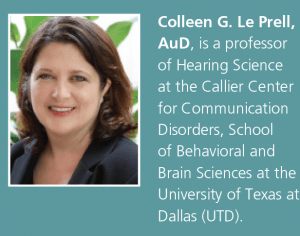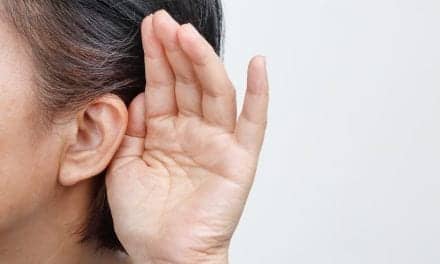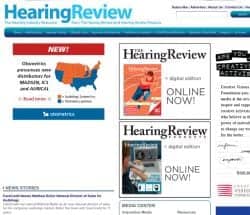Research | December 2017 Hearing Review
An overview of HPDs, new legislation, and recommendations for rifles with silencers
Sound level suppressors (also known as “silencers”) on firearms reduce—but do not eliminate—hazardous noise exposure, especially for AR-15 or similar semiautomatic rifles. At this time, the best advice is dual use of both HPDs and suppressors—particularly for those shooting weapons that produce dangerously high sound levels. For shooters who are reluctant to use HPDs, electronic HPDs should be considered as an option.
Several years ago, our research team at the Callier Center for Communication Disorders became interested in the challenges of hearing conservation for shooters, which broadly includes hunters, target shooters, law enforcement officers, and soldiers. For some of these groups, shooting is a recreational activity, and for others, there is a requirement to engage in weapons training annually, or perhaps even more frequently.
Our initial interests and activities were stimulated by a query from Officer Ryan Scott, who was at that time a member of the High Springs Police Department, in High Springs, Fla. Officer Scott communicated concern over a national trend of deploying ArmaLite rifle model 15 (AR-15) rifles among law enforcement officers in the United States and, in particular, the use of short-barreled AR-15 rifles to increase maneuverability during indoor engagements and in urban settings.
Peak Impulse Levels and HPDs
During our initial efforts to assess sound level as a function of barrel length, we made significant efforts to identify appropriate measurement strategies. This required careful selection of measurement location, appropriate microphones and pressure probes, and recording equipment with a sufficiently high sampling rate. These issues have been identified and discussed in detail by others,1-5 but relatively recent examples of sound-level meters (SLMs) being used to measure the sound levels associated with firearm discharges can still be found (see, for example, the 2011 papers by Branch6 and Guida et al7).
We provided a short overview of these issues when we discovered differences of at least 6 dB—and often as much as 12 dB or more—when comparing peak level measurements collected simultaneously via a Larson Davis Model 831 SLM set for impulse noise to those collected using a Pulse spectrum analyzer (Brüel and Kjær model 3052-A-030) with a 256-kHz sampling rate.8 In every case, the SLM underestimated the peak SPL relative to the levels measured using the spectrum analyzer. Using the appropriate technical equipment, peak sound levels measured at the position of the shooters ears during discharge of a 10.5” short-barreled rifle (SBR) were found to be approximately 170 dB SPL, and with the addition of various muzzle brakes commonly used to control recoil from short rifles, peak sound levels were as high as 180-185 dB SPL.9
Given the dangerously high levels measured, the selection of hearing protection devices (HPDs) would logically include recommendations for dual protection using both earplugs and earmuffs. The specific selection of HPDs is compromised, however, by the way in which HPD attenuation is calculated and reported. In the United States, through the Noise Control Act of 1972, Congress gave regulatory authority to the US Environmental Protection Agency (EPA) to rate equipment and devices that either produce noise or claim to reduce noise. This was accomplished in 1978, when the promulgation of 40 CFR 211 put into place a new regulatory framework for product noise labeling. The Noise Reduction Rating (NRR) specifically created a single “consumer-friendly” number that would provide guidance to consumers regarding the amount of sound attenuation provided by an HPD—at least in a controlled laboratory setting.
A well-known shortcoming of the NRR is the extent to which real-world use of HPDs fails to achieve the level of attenuation accomplished in the controlled laboratory setting.10,11 A second major issue, however, is the shortcoming of the NRR in predicting attenuation of high-level, short-duration, impulse noise. Two of the strategies that have emerged are impulse peak insertion loss (IPIL), which is specifically described in ANSI/ASA S12.42-2010, and impulsive spectral insertion loss (ISIL).12-14 A complete technical explanation of IPIL and ISIL strategies is beyond the scope of this article, and readers who are interested in more specific technical information should review the recent report by Fackler et al14 who describe IPIL and ISIL in detail.
In brief, IPIL measurement results in a single number representing dB reduction in SPL in the HPD-occluded ear relative to the unoccluded ear, based on data collected using an acoustic test fixture and an acoustic test signal that meet highly specific criteria. In contrast to the single dB value generated as an IPIL measurement, the outcome of the ISIL analysis is a curve illustrating the frequency dependence of the attenuation properties. As noted by Fackler et al,14 for IPIL values generated per ANSI/ASA S12.42-2010 protocols to be relevant to firearm discharges, modifications to the standard are needed; S12.42-2010 specifies the use of acoustic test signals with A-durations of at least 0.5 ms and not more than 2 ms, whereas AR-15 rifle discharge produces impulses with A-durations of less than 0.5 ms.
For those not familiar with impulse noise, the A-duration is defined as the time from the onset of the impulse to the first zero pressure level crossing.15 Consumers would perhaps be better able to select appropriate HPDs for use during firearm discharges if an IPIL or ISIL-like rating scheme was implemented; however, changes to the US regulatory framework for HPDs seem relatively unlikely at this time, as the EPA Office of Noise Abatement and Control (ONAC) was defunded in 1981.
Use of Silencers/Suppressors
A second strategy for reducing the dangerously high sound levels produced by firearms that could be used in combination with HPDs is the use of a suppressor or, as often referred to erroneously, a “silencer.” We assessed a variety of suppressors as a means to reduce the hazardous sound levels produced by derivatives of the AR-15. This rifle is a common and immensely popular firearm in both the US and Canada for both law enforcement and recreational purposes. We found that overall suppression ranged from 7-32 dB across conditions (with variables including ear, ammunition, weapon, etc), and, with the exception of a subset of conditions in which subsonic ammunition was used, discharge levels routinely exceeded 140 dB SPL despite the use of a suppressor.9
Guidance from the Occupational Safety and Health Administration (OSHA) states that, “Exposure to impulsive or impact noise should not exceed 140-dB peak sound pressure level.”16 Thus, the use of a suppressor device did not make these discharges “hearing safe” in the absence of HPDs.
To be clear, the combination of a suppressor and HPDs will be safer than the use of HPDs alone. However, the use of a suppressor alone is not adequate for hearing loss prevention purposes when using an AR-15 or similar rifle. This important message has been brought forward to the law enforcement community by Officer Scott, who is now a Deputy Sheriff with the Alachua County Sheriff’s Office in Florida. In his educational workshop, “Firearms Training and Hearing Loss,” he advocates for the use of suppressors in combination with technological solutions and devices that integrate hearing protection with radio communication systems, so that situational awareness is preserved for those whose hearing is critical to job performance and safety. Officer Scott received a 2017 Safe-in-Sound Excellence in Hearing Loss Prevention Award from The National Institute for Occupational Safety and Health (NIOSH) and the National Hearing Conservation Association (NHCA) for his efforts to bring solutions to the law enforcement community.17 The NHCA guidance document, prepared by the NHCA Task Force on Prevention of Noise-Induced Hearing Loss from Firearm Noise, provides guidance on both suppressors and electronic HPD options for recreational firearm users, noting the potential reluctance of many hunters to wear HPDs while hunting.18
The Hearing Protection Act
In the United States, suppressors have received increasing attention over the past year due to recent legislative efforts intended to make the acquisition of suppressors easier and less expensive for those that wish to acquire them. In Europe, suppressor laws vary. Some countries, such as Norway, have no regulations; others, such as Germany and the UK, have much tighter regulations and a “good cause” is required. In January 2017, the “Hearing Protection Act of 2017” was introduced in the House of Representatives (HR 367) along with the Senate companion bill S.59. As per the online summary of the bill:
This bill amends the Internal Revenue Code to: (1) eliminate the $200 transfer tax on firearm silencers, and (2) treat any person who acquires or possesses a firearm silencer as meeting any registration or licensing requirements of the National Firearms Act with respect to such silencer. Any person who pays a transfer tax on a silencer after October 22, 2015, may receive a refund of such tax. The bill amends the federal criminal code to preempt state or local laws that tax or regulate firearm silencers.19
In effect, passage of this bill would replace the monthslong approval process with an instant background check (as required for the initial firearm purchase), eliminate the $200 tax for transferring the device registration, and eliminate federal registration of the device. Succinctly, any person who can legally own a firearm would be eligible to legally own a suppressor without additional fees or waiting periods. A useful summary of the arguments for, and against, this bill was provided in a “fact-checking” article in The Washington Post.20 After reviewing various claims, they conclude the bill might be more appropriately named “The Paperwork Reduction Act” as the devices do not mitigate the need for hearing protection, and the main impact of the bill is to loosen restrictions on the purchase of suppressors.
The conclusion by Kessler that suppressors in combination with HPDs will work better than HPDs or suppressors alone is audiologically reasonable. I also share Kessler’s sentiment that the naming of the bill may be misleading; there is reason to be concerned that by naming the bill “The Hearing Protection Act,” some consumers might assume a suppressed weapon will be “hearing safe.”
The US Congress continues to actively consider the “Hearing Protection Act of 2017” (HR 367/S.59). At this time, H.R. 367 has been referred to the House Ways and Means Committee and the House Judiciary Committee (House Judiciary Subcommittee on Crime, Terrorism, Homeland Security, and Investigations), and S.59 has been referred to the Senate Finance Committee. Other related bills have also emerged. For example, in June, 2017, Senate bill S.1505, “Silencers Help Us Save Hearing” (“SHUSH Act”), was released. Both this bill and H.R. 3139 (released in the House of Representatives in June 2017) are intended to provide that silencers be treated the same as firearms accessories. More recently, in September 2017, related changes were proposed with the release of the much broader H.R. 3668, titled, “Sportsmen’s Heritage And Recreational Enhancement (SHARE) Act” which includes elements of the Hearing Protection Act of 2017 as well as many other unrelated legislative changes. The full text of all of these proposed bills is available at www.congress.gov and interested readers are encouraged to review the complete text. None of the above bills have any requirements for testing or reporting of sound level reductions achieved by suppressors.
The development of explicit testing and reporting requirements for sound-level reductions accomplished via the use of a given make and model of suppressor would be a significant advance in consumer protection. Ideally, manufacturer product safety data would be required to report sound-level attenuation in standardized conditions, with ammunition, bullet weight, muzzle velocity, propellant charge, and the location where measurements were made (ie, at the location of a shooter’s ears or a fixed position relative to the muzzle), all required to be constant across tests, as all of these variables can affect measured levels.
Armed with consistent information for both suppressors and HPDs, shooters could make informed decisions about the selection of both suppressor devices and HPDs to bring sound levels well below the 140-dB SPL limit. Shooters should be reminded that 140-dB SPL is the sound level a single shot should not exceed. The more shooting an individual does (or, the more shooting activity on the range near the shooter), the more attenuation is needed, as risk for hearing loss is dictated by both the sound level of the impulses and the number of impulses.
We know that the distribution of impulses over time also influences the risk of hearing loss,21 but incorporating such data into a risk assessment is a challenge that may only be fully resolved with the development of a real-time dosimeter for shooters to use for monitoring their individual exposure. Interestingly, efforts to develop such a device for use by military personnel in hazardous settings are ongoing.22
Conclusions
Firearm noise is dangerously loud, and those who engage in hunting or other shooting activities should be concerned and counseled about the urgent need to protect their hearing. Suppressors reduce—but do not eliminate—hazardous noise exposure, especially for AR-15 or similar semiautomatic rifles. Many of the bolt action rifles and handguns used by recreational shooters have lower discharge levels (unpublished observations), and suppressors are more effective in reducing sound levels for at least some of these platforms. However, peer-reviewed presentations of the complete data sets are necessary before evidence-based guidance can be generated.
At this time, the best advice is dual use of both HPDs and suppressors—particularly for those shooting AR-15 and similar weapons which produce dangerously high sound levels. For shooters who are reluctant to use HPDs, electronic HPDs should be considered as an option. Those interested in more information should review the position paper of the NHCA,18 and other literature cited here for specific details and information.
Disclosures and Acknowledgements
The author’s research on firearm discharge levels and reductions in discharge level via suppressor devices was funded by a contract from the American Suppressor Association (ASA).
The author gratefully acknowledges conversations and collaborations with Edward Lobarinas, Ryan Scott, Christopher Spankovich, and several members of the National Hearing Conservation Association (NHCA) Task Force on Prevention of Noise-Induced Hearing Loss from Firearm Noise, including (but not limited to) Michael Stewart, Deanna Meinke, Gregory A. Flamme, and William J. Murphy. I am especially grateful to Dr Murphy for his comments on the history of noise regulation in the United States, and Dr Meinke who shared her knowledge and thoughts related to shortcomings in the regulations related to labeling of HPDs. Drs Lobarinas, Murphy, and Meinke thoughtfully reviewed this document and I am grateful for their suggestions.
A version of this article was originally published at www.canadianaudiologist.ca and appears here with permission of editor Marshall Chasin, AuD, and the publisher.
Correspondence can be addressed to HR or Dr Le Prell at: [email protected]
Original citation for this article: Le Prell CG. Sound level suppressors for firearm noise reduction: Implications for hearing conservation. Hearing Review. 2017;24(12):26-30.
References
-
Garinther GR, Moreland JB. Transducer Techniques for Measuring the Effect of Small-Arms’ Noise on Hearing. US Army Technical memorandum;1965:11-65.
-
Brinkmann HH. Techniques and procedures for the measurement of impulse noise. Paper presented at: RTO HFM Lecture Series on “Damage Risk from Impulse Noise.” Maryland, June 5-6, 2000; Meppen,Germany, June 15-16, 2000 (published in RTO-EN-11).
-
Kardous CA, Franks JR, Davis RR. NIOSH/NHCA Best-practices workshop on impulsive noise. Noise Control Eng J. March 2005;53(2):53-60.
-
Rasmussen P, Flamme G, Stewart M, Meinke D, Lankford J. Measuring recreational firearm noise. Sound & Vibrat. August 2009;43(8):14-18.
-
Beck SD, Nakasone H, Marr KW. Variations in recorded acoustic gunshot waveforms generated by small firearms. J Acoust Soc Am. April 2011;129(4):1748-1759.
-
Branch MP. Comparison of muzzle suppression and ear-level hearing protection in firearm use. Otolaryngol Head Neck Surg. 2011;144(6):950-953.
-
Guida HL, Diniz TH, Kinoshita SK. Acoustic and psychoacoustic analysis of the noise produced by the police force firearms. Braz J Otorhinolaryngol. March/April 2011;77(2):163-170.
-
Lobarinas E, Le Prell CG. Impulse noise produced by weapons: Implications for hearing conservation. NHCA Spectrum. June 2014;31(1):1,6-8.
-
Lobarinas E, Scott R, Spankovich C, Le Prell CG. Differential effects of suppressors on hazardous sound pressure levels generated by AR-15 rifles: Considerations for recreational shooters, law enforcement, and the military. Int J Audiol. 2016;55 [Suppl 1]:S59-S71.
-
NIOSH. Criteria for a Recommended Standard, Occupational Noise Exposure. DHHS (NIOSH) Publication No. 98-126;1998.
-
Berger EH. Hearing protection devices. In: Berger EH, Royster LH, Royster JD, Driscoll DP, Layne M, eds. The Noise Manual. 5th ed. Fairfax, Va: American Industrial Hygiene Association;2003:379-454.
-
Murphy WJ, Flamme GA, Meinke DK, et al. Measurement of impulse peak insertion loss for four hearing protection devices in field conditions. Int J Audiol. February 2012;51[Suppl 1]:S31-S42.
-
Murphy WJ, Fackler CJ, Berger EH, Shaw PB, Stergar M. Measurement of impulse peak insertion loss from two acoustic test fixtures and four hearing protector conditions with an acoustic shock tube. Noise Health. 2015;17(78):364-373.
-
Fackler CJ, Berger EH, Murphy WJ, Stergar ME. Spectral analysis of hearing protector impulsive insertion loss. Int J Audiol. 2017;56[SUP 1]:13-21.
-
US Department of Defense. MIL-STD-1474E 2015. Department of Defense Design Criteria Standard Noise Limits;2015. Available at: https://www.arl.army.mil/www/pages/343/MIL-STD-1474E-Final-15Apr2015.pdf
-
US Occupational Safety and Health Administration (OSHA). 29 CFR 1910.95. Occupational Noise Exposure; Hearing Conservation Amendment; Effective March 8, 1983.
-
Deputy sheriff awarded 2017 NIOSH/NHCA Hearing Loss Prevention Award. February 28, 2017. Available at: https://hearingreview.com/2017/02/deputy-sheriff-awarded-2017-nioshnhca-hearing-loss-prevention-award
-
National Hearing Conservation Association (NHCA). NHCA Position Statement: Recreational Firearm Noise. March 16, 2017. Available at: http://c.ymcdn.com/sites/www.hearingconservation.org/resource/resmgr/position_statements/2017/NHCA_position_paper_on_firea.pdf
-
US House of Representatives. HR 367–Hearing Protection Act of 2017. Introduced January 9, 2017. Available at: https://www.congress.gov/bill/115th-congress/house-bill/367
-
Kessler G. 2017. Are firearms with a silencer ‘quiet’? Available at: https://www.washingtonpost.com/news/fact-checker/wp/2017/03/20/are-firearms-with-a-silencer-quiet/?utm_term=.e86899eabe54
-
Danielson R, Henderson D, Gratton MA, Bianchi L, Salvi R. The importance of “temporal pattern” in traumatic impulse noise exposures. J Acoust Soc Am. July 1991;90(1):209-218.
-
Smalt CJ, Lacirignola J, Davis SK, Calamia PT, Collins PP. Noise dosimetry for tactical environments. Hear Res. June 2017;349:42-54.






